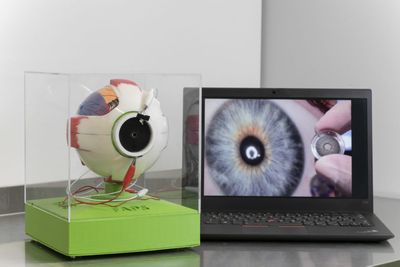Iris implants made of smart materials
For your eyes only
Robot arms that follow human movement patterns, artificial skin or movable iris implants: dielectric elastomers are bringing things which were previously strictly confined to the realms of science fiction to within our reach.
Dielectric elastomers are smart materials structured in alternating layers. A layer of silicone elastomer is followed by a layer of graphene, followed by silicone elastomer, followed by graphene and so on until the desired thickness is achieved. The conductive graphene layers can be made to contract by applying alternating positive and negative electrical currents. The silicone layers trapped in the middle retain their volume even under pressure, but are pressed together and ooze out between the layers of graphene, like chocolate spread between two slices of bread. If the electrical current is removed, the magnetic field wanes and the silicone layers return to their original state.
‘We hope to put this movement to good use,’ says Sina Martin, who studied medical engineering before working as a research associate at FAPS. Her research focuses on applications for dielectric elastomers such as these. ‘Our main focus is currently on using the effect for artificial muscles.’ This is also the topic of Sina Martin’s thesis. At the same time, she is also designing iris implants that work following the same principle.
Replacing rigid implants
The muscles in the iris regulate the amount of light entering the eye by changing the diameter of the pupil. People who are born with a dysfunctional iris or who suffer from permanent damage to the iris have until now only had the option of wearing tinted glasses to compensate for this essential function and shield their eyes from excessive light. A rigid cosmetic implant helps to disguise the abnormality or injury, but has not until now been able to reproduce the iris’ function of reducing glare from bright light. Sina Martin’s artificial iris, however, is designed to react to changes in light like its natural counterpart and could make rigid aids like these a thing of the past.
In order for this to work, light sensors in the eye must be able to detect light and send a signal to the artificial iris, which is basically a disc with an aperture in its centre. The light signal causes the graphene layers to contract. The silicone elastomers are squeezed at the inner edge of the disc, making the opening smaller and closing the pupil.
Innovative solution
Unfortunately, the silicone layers also expand towards the outer edge. In the case of iris implants, this is an undesired effect and Sina Martin is focusing in her dissertation on ways to minimise it. ‘I am trying to adjust the electrical field to control the expansion and make the silicone elastomers only squeeze out in one direction.’
Another problem is energy supply and transfer. One solution may be cochlea implants like those used by the deaf. The functional unit for such implants is placed under the skin, and serves to transform acoustic or digital signals into electrical impulses. The transmitter coil is placed on top of the skin. The same principle could be used in future for contactless energy transfer in the case of iris implants, according to Martin.
The graphene-silicone muscles are not only capable of transforming electrical signals into movement, they can even simultaneously detect movement and pressure.
‘Using another electrical signal, we can monitor how far the material has expanded or whether the electromagnetic field changes when another object with its own field comes close. This would mean that it may be possible for the whole system to self-regulate,’ explains Sina Martin. Other areas of application could also be plausible. For example monitoring the distribution of pressure in orthotic devices or orthopaedic shoes Other possible applications may include strain gauges aimed at optimising movements in the context of sport or for visual effects in films, such as motion capturing.
For now, however, Sina Martin is concentrating on the artificial iris implants. ‘In future it may even be possible to construct adjustable lenses for the treatment of long and short sightedness using artificial muscles. Some people may even be able to do without their glasses, but there is still a lot of research to be done before we are at that stage,’ she says.
More information: Institute for Factory Automation and Production Systems
